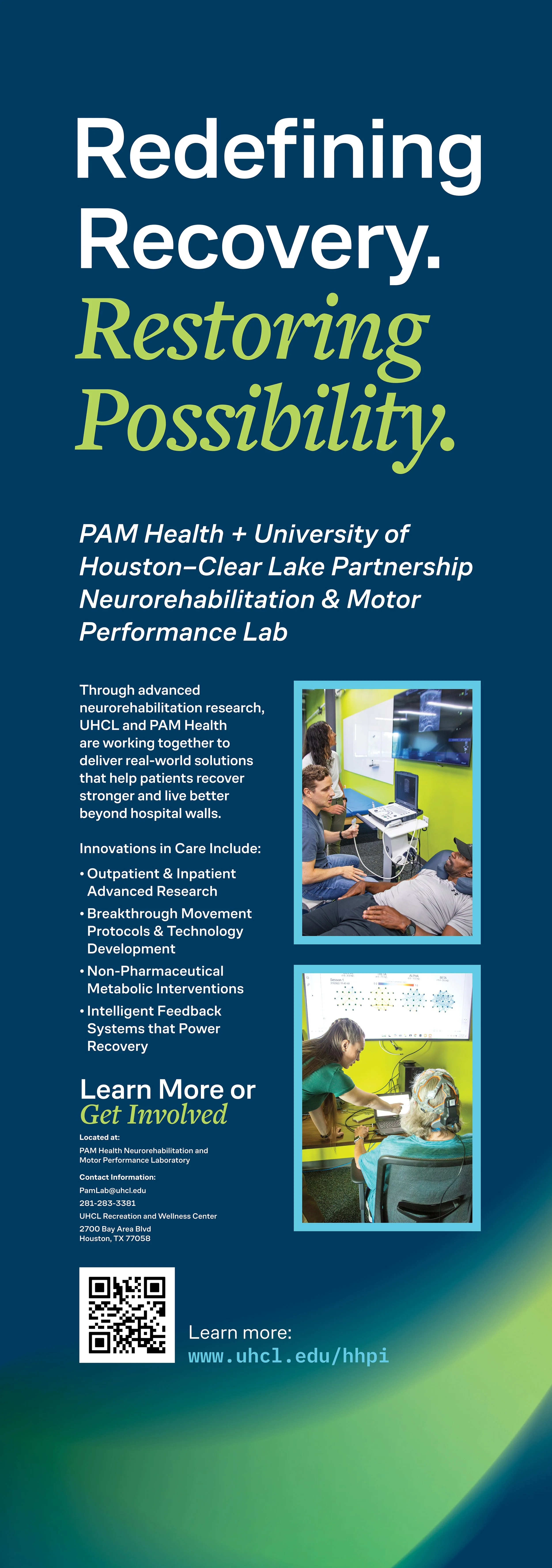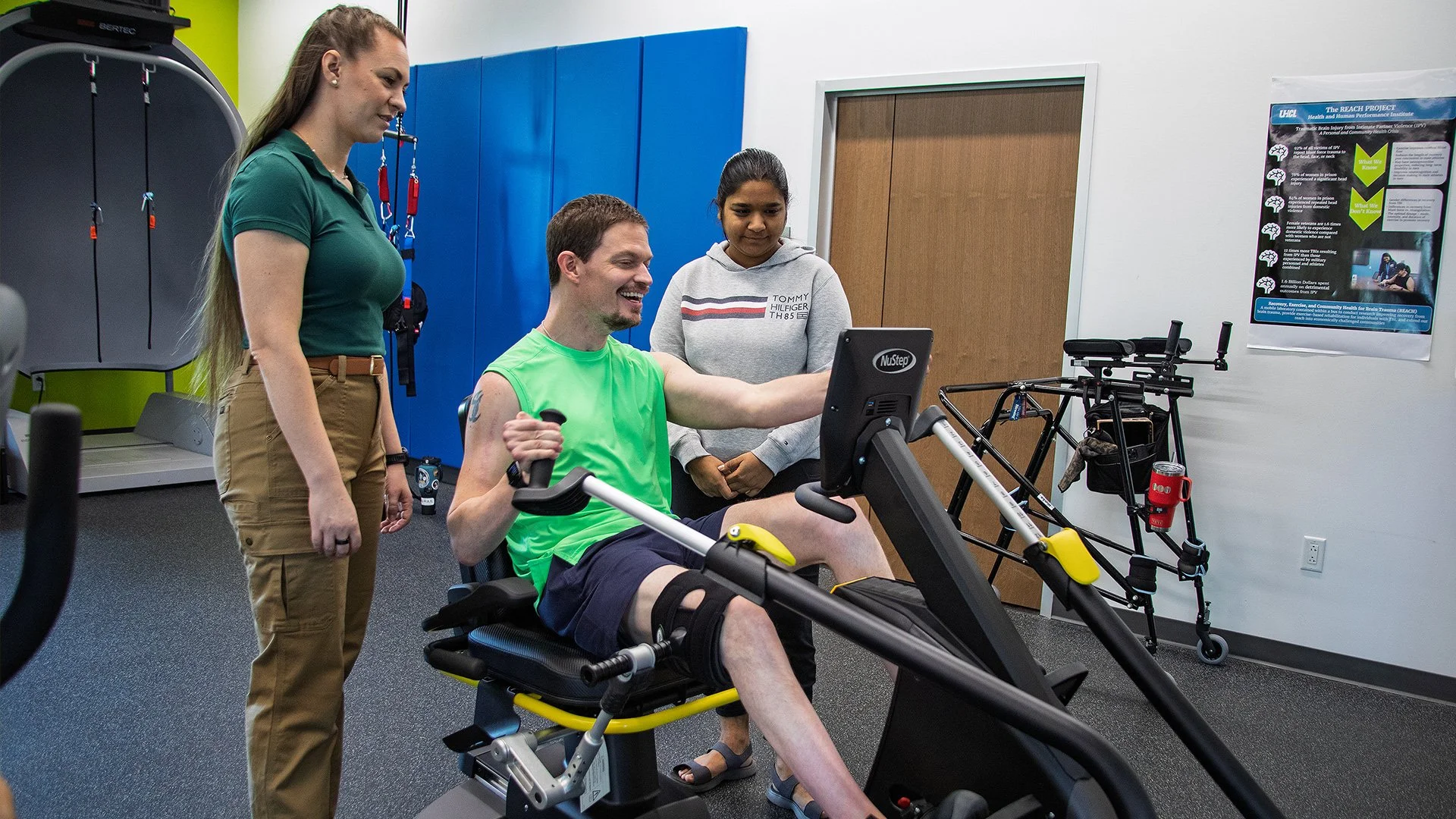Refining recovery. Restoring possibility.
Written by: Lauren Taylor Sawyer

Sean Carter
“Exercise has given me strength, structure, and purpose. I am proud to say that who I am today is not the same person I was 20 years ago. People living with a TBI are capable of so much more than they realize, and I hope my story can help change the narrative about what recovery really means.”
The University of Houston-Clear Lake (UHCL) has long been dedicated to transforming lives through research, education, and community engagement. Now, a landmark partnership with PAM Health is expanding that mission in a new way through the newly named PAM Health Neurorehabilitation and Motor Performance Lab at UHCL's Health and Human Performance Institute (HHPI).
The facility was officially unveiled during a ribbon-cutting ceremony held on September 23, 2025, marking a milestone moment in healthcare and academic collaboration.
“Tonight is about more than a new facility or the naming of the facility,” said UHCL President Dr. Richard Walker. “It’s about the power of partnership.”
This partnership represents more than a name on a wall. It is a visionary alignment between a leading rehabilitation healthcare provider and a university committed to innovation and social impact. The collaboration will support a multi-year, interdisciplinary research initiative focused on improving the lives of individuals with neurological conditions such as Parkinson's disease, traumatic brain injury (TBI), and stroke.
Dr. William Amonette, professor in the Department of Health, Human, and Biomedical Sciences and executive director of HHPI, will lead the research as principal investigator. He brings years of experience exploring exercise and nutrition's impact on people with chronic diseases and disabilities. The partnership also opens the door to rare, hands-on research experience in a high-need area of healthcare, helping students launch careers in rehabilitation and biomedical science.
"Mr. Misitano sincerely cares about people. That was my very first impression of him," said Amonette, speaking of PAM Health CEO Anthony Misitano. "He's investing in research because he genuinely cares. He understands the impact of research — one novel discovery could change countless lives."
Amonette's vision is rooted in understanding the gaps in the current healthcare system.
"The problem in the healthcare system right now is that whenever you have a TBI, you have about nine to 13 months of insurance coverage. When that ends, they give you a chair and allow you to function, but rehabilitation essentially stops," Amonette explained. "And you can't just go to the gym, right? It's not easy to navigate 24 Hour Fitness. So, when we built this place, our motto was: 'We want to be the place you go when there's nowhere else you can go.'"
That philosophy helped shape the lab's purpose and its connection to real people, like Sean Carter, a young man living with the lasting effects of a TBI. In March 2005, Sean was involved in a car crash that completely changed his life.
“I had several fractures, and when I emerged from a 39-day coma, I was unable to walk or talk,” Sean said. “So many things were wrong with my body that it might be easier to tell you what worked than what didn’t work. My cognition was intact, but my body would not respond.”
The road looked uncertain, and at times, Sean said he could not see the bigger picture, but that changed when he found UHCL’s HHPI. Sean and his family drove from College Station twice a week to work with the HHPI team at UHCL, eventually relocating to the area.
“Exercise has given me strength, structure, and purpose. I am proud to say that who I am today is not the same person I was 20 years ago.” Sean said. “People living with a TBI are capable of so much more than they realize, and I hope my story can help change the narrative about what recovery really means.”
Dr. Lewis Clarke of PAM Health Rehabilitation Hospital of Clear Lake North played a critical role in initiating the partnership, connecting Misitano with Dr. Amonette after years of discussing a collaborative research project. "That Misitano is a visionary," Clarke said.
The lab has advanced tools to analyze everything from cognitive function and memory to EEG brain activity and neuromotor performance. Together, UHCL and PAM Health will launch controlled trials to investigate biomarkers like brain-derived neurotrophic factor (BDNF) and nerve growth factor (NGF), exploring how tailored interventions influence brain regeneration.
"The PAM Health Neurorehabilitation and Motor Performance Lab is equipped with every conceivable sophisticated motor and cognitive assessment tool imaginable," said Clarke. "We will be utilizing EEG coherence evaluations to visualize changes in brain connectivity while concurrently analyzing balance, strength, coordination, memory, and cognitive function in a patient population that includes Parkinson's, stroke, TBI, ALS, and dementias."
The collaboration also includes a structured patient pathway. Patients will begin with inpatient rehabilitation at PAM Health facilities, where baseline functional and laboratory data will be collected. After discharge, they will continue outpatient care and therapy at UHCL, allowing for ongoing research and support beyond hospital walls.
For UHCL students, this is more than research — it is an invitation to lead.
"This represents an unparalleled opportunity for these students to both train and contribute to new research in neurorehabilitation," Clarke said. "This is a rare marriage of academics and clinical medicine. Both resources provide a rich and fertile ground to better understand the rapidly evolving science of neuroregeneration and how that translates into patient outcomes."
Ultimately, Amonette views this partnership as a catalyst for national impact. The research conducted at the lab will not only serve local patients, but it also has the potential to become a model of care that can be replicated across the country.
"With conditions like Parkinson's disease and TBI, patients are never truly 'cured,'" Amonette said. "But through research, we can find better ways to improve their quality of life and long-term health."
Walker echoed this long-term vision: “As I look to the future, I see this lab as a living classroom, a community resource, and a symbol of innovation. Together, we are building something that will have an impact for years to come,” he said.
This is research with purpose, driven by compassion and powered by partnership. UHCL students have a chance to change lives, including their own.
Contacts
Lauren Sawyer
Coordinator of Media Relations
Daniel Ramirez
Associate Vice President of Marketing and Communications
The Vision
As the content strategist behind the collaborative brand voice for the PAM Health Neurorehabilitation and Motor Performance Laboratory, I developed the marketing slogan “Redefining Recovery. Restoring Possibility.” to encapsulate the partnership’s mission of transforming neurorehabilitation science.
My work unified the voices of the University of Houston–Clear Lake and PAM Health into a cohesive narrative that highlights innovation, research leadership, and human impact.
The result is a compelling story of progress—one that positions the lab at the forefront of clinical research, technology, and the science of recovery, inspiring hope and redefining what’s possible for patients worldwide.





